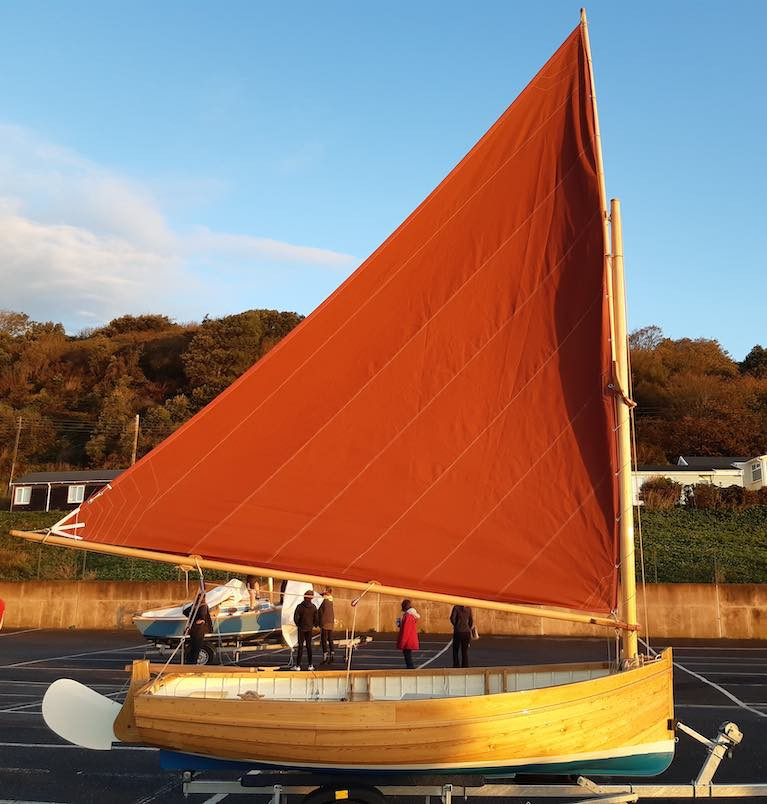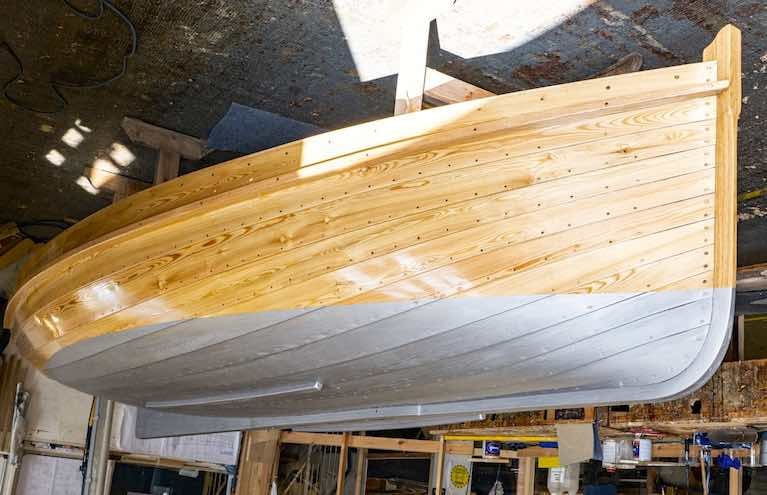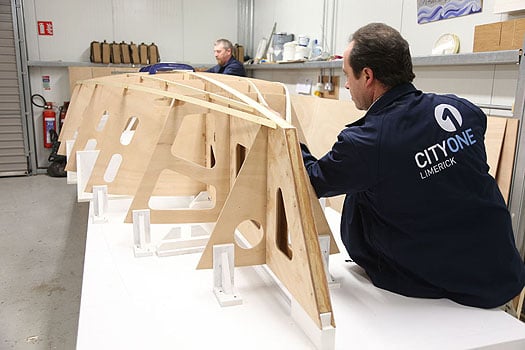Displaying items by tag: Droleen
Bray Sailing Club and the Droleen Dinghy in Focus at Historical Society Talk by Vincent Delany
A talk on the maritime development of Bray Town in the 19th century will be held by Vincent Delany, a renowned maritime historian, at the Royal Hotel in Bray on November 16th, 2023 at 8:00 pm.
During the talk, Vincent Delany will highlight the key people who held important positions in the town in the 19th century. He will delve into the great Regattas that took place in Bray from 1862, which attracted thousands of visitors from Dublin who travelled by train to attend them.
 A recently built Droleen is ready to race
A recently built Droleen is ready to race
The Regattas contributed to the establishment of the Bray Sailing Club in 1896, whose members built a unique one-design dinghy for Bray known as the Droleen that did not survive for long.
Vincent Delany will describe the reasons behind the collapse of the class and how it was revived in the 21st century. Today, there are six known Droleens ready to race.
Launch of ‘Bray Sailing Club’s Droleen Dinghy’ Book
On Friday evening, April 1, Vincent Delany launched ‘Bray Sailing Club’s Droleen Dinghy’ book at the County Wicklow club in Bray harbour.
Vincent’s Co-author Jim Horgan was at the launch. Unfortunately the third author, Michael Weed was isolated in Donegal and unable to attend.
The book describes how the Droleen is the third oldest one-design in the world after the Water Wag (1886) and the Sutton Yacht & Boat Club’s Nipper Class.
Also at the book launch was Esther De Groot whose late husband Frank De Groot was one of the driving forces behind the Bray Droleen Project.
No Droleens survive from the 19th century, but five boats have been built within the past 20 years- and in 2021 they held their first-ever Irish Droleen Championship in Dun Laoghaire. It is planned to repeat this in Bray in 2022.
Bray Sailing Club’s Droleen Dinghy is €20 and is available from [email protected] or 086 8575374.
Bray Droleen Class Celebrate First Ever Irish Championships at Royal St. George Yacht Club
This was the first-ever Irish Championships for the Bray Droleen Class, despite the 12-foot catboats being designed by William Ogilvy in 1896. How was this the case? The nine boat fleet raced regularly between 1897 and 1902, and thereafter the fleet in Bray collapsed for a number of reasons. In the 19th century, there were no races for the Droleens except off Bray Promenade and some east coast regattas. There was no racing for the Class in the 20th Century. Since 2013, many boats have been built in various parts of the country, so when they came together for a championship in Dun Laoghaire on 29 August, this was their first National Championship.
The Droleens had previously raced in Kingstown and sailed from Bray to compete at the Kingstown Township Regatta. This year all but one Droleen arrived by road trailer, and one arrived on a 20-ton seaweed truck which managed to stop the traffic in Dun Laoghaire while unloading its precious cargo.
 Bray Droleens - Windyridge, Galway Girl and Bray Heritage
Bray Droleens - Windyridge, Galway Girl and Bray Heritage
In race one, held in a six-knot breeze, Mark Delany sailing Philip Harvey's 'Windyridge' which was built in Cavan by Paddy Sheridan, dominated and took the gun with Jim Horgan's self-built 'Galway Girl' in second place. Paul and Tony Finnegan's 'Bray Heritage, ' which was built by a team of volunteers under Frank DeGroot, was late for the start and was unable to make an impression. Race two resulted in the same finishing order, 'Galway Girl' being hampered by the enclosed environment of Dun Laoghaire harbour and preferring the open waters of Greatman's Bay off Connemara. All the competitors came ashore for a sociable lunch in the clubhouse and conversations about boats and boatbuilding and how to rig the Droleens to best effect. In the first afternoon race over a smaller course, 'Windyridge' again dominated while 'Galway Girl' retired and 'Bray Heritage' was challenged by the light winds. In the final race 'Windyridge' managed to pull off a port tack start, much to the surprise of the other competitors.
 Galway Girl
Galway Girl
 Windyridge
Windyridge
At the prize-giving at the Royal St George Yacht Club, championship chairman Vincent Delany expressed a hope that the Droleens would compete together again before the end of the season, and hopefully in Bray, and including Michael Weed's beautiful 'Donegal' Droleen.
Return of the Bray 'Droleen' Dinghies to Royal St George Yacht Club for 'Irish Times Challenge Cup'
At the end of 1896, Bray Sailing Club decided to hold a competition among its members to design a new one-design sailing dinghy suitable for the challenging marine conditions prevailing off Bray, Co. Wicklow. The winner of the competition was a twenty-six-year-old draper, William Ogilvy, an experienced sailor who proposed an open cat-boat, twelve feet long by six feet beam to be built with best quality spruce and elm. The boat was designed to carry a 100 sq. ft. mainsail and a traditional spinnaker of cotton flown from a long spinnaker pole.
A contract was entered with Mr Greg Foley of Ringsend to build seven boats, which were named 'Droleens' (or wrens), and deliver them to Bray by train, all for £9 each. The sails were made by Madders of Wivenhoe, Essex, England, for £1-8s. These little boats provide such sport that during 1897, that Foley was given two more orders to build Droleens to join the fleet at Bray. Being very sea-worthy, competed at regattas up and down the County Dublin coast, at Howth Sailing Club, Clontarf Yacht and Boat Club, at Kingstown Township Regatta (now Dun Laoghaire) and at Dalkey Regatta.
In 1897 The Irish Times presented a beautiful silver cup called the 'Irish Times Challenge Cup' to be competed for by the Droleens, which was won by Mr Joseph Edward Mills in Katie. Mr Mills was a caterer and confectioner who owned a shop in Merrion Row in Dublin with his son, Joseph Edward junior.
 (Above and inscription close up below) The beautiful silver cup called the 'Irish Times Challenge Cup' has been rediscovered and will be raced for again
(Above and inscription close up below) The beautiful silver cup called the 'Irish Times Challenge Cup' has been rediscovered and will be raced for again

Fortunately, the 'Irish Times Challenge Cup' was rediscovered, and it seemed appropriate that the Droleens should again compete for the silver cup.
On 29 August this year, the Droleens will again take to the water, this time in Dun Laoghaire, hosted by the Royal St George Yacht Club for the first time in one hundred and twenty-four years to compete again for the historic 'Irish Times Challenge Cup.' Are there any Droleens in existence? We have promises of four boats coming to Dun Laoghaire, a volunteer-built Droleen coming from Bray (of course), a Lyme Regis Academy built Droleen from Donegal, a Co. Cavan professionally built Droleen belonging to a Dublin owner and a school built Droleen from Barna, Co. Galway.
 A Droleen sailing in Bray Harbour in County Wicklow
A Droleen sailing in Bray Harbour in County Wicklow
Never have any of these boats been previously raced or been seen together.
The Droleens, being twelve feet long, will compete against the 1913 International 12 Foot Dinghies and the 1969 Dublin Bay Sailing Club 12 Foot Dinghy, which shares the 1913 hull but with a more modern rig. Will the Droleens be quicker than the newer 12-foot designs? The Droleens do have sufficient beam to carry a larger sail area. However, we have to wait until 29 August to find out which performs best in Dun Laoghaire.
The Royal St George Yacht Club have agreed to hold the Irish 12 Foot Championships in 2021. In a remarkable development, The Bray Droleen 12 Foot Class will join the International 12 Foot Dinghies and their sisters the Dublin Bay 12 Foot Dinghies for the first time.
For the Bray Droleens, this will be their first-ever Irish Championships, and the first time they have sailed in Dun Laoghaire since it changed its name from Kingstown.
From 1897, Droleens used to be regular attendees at the Kingstown Township Regatta (The predecessor of today's Volvo Dun Laoghaire Regatta), and sailed up from Bray across beautiful Killiney Bay in order to compete. Several new Bray Droleens have been built since the year 2000, (many of which were featured on this website) and are now located around the country, including those in Counties Donegal, Galway, Dublin and at the home port of Bray, Co. Wicklow.
 International 12 Foot Dinghies (above) and (below) their sisters the Dublin Bay 12 Foot Dinghies (same hull shape but with mainsail and jib)
International 12 Foot Dinghies (above) and (below) their sisters the Dublin Bay 12 Foot Dinghies (same hull shape but with mainsail and jib)

For the International 12 Foot Dinghies and their sisters the Dublin Bay 12 Foot Dinghies (same hull shape but with mainsail and jib) they have been holding their annual Irish Championships at the Royal St George Yacht Club since 2011.
With all three classes sharing an overall length of 12 feet (3.65m.) and a sail area of about 100sq.ft (9.29m2) all should have a similar performance and will race together as a single fleet. It will be interesting to compare their speeds, and in particular, it will be interesting to see if it is an advantage to the Droleens to fly their spinnakers (the only one of the three classes to permit the use of a spinnaker).
The event takes place on Sunday, 29 August 2021 at the Royal St George Yacht Club, Dun Laoghaire
Anybody interested in finding out about this event or 12 Foot Dinghies should contact [email protected] or [email protected] for more information.
Howth RNLI to Benefit from Dublin Bay Old Gaffers Zoom Session On Building Bray Droleen Dinghy
The Dublin Bay Old Gaffers Association winter talks series on Zoom continues on Thursday (November 26th) with a deeper insight into a classic boat-building story that has featured recently on Afloat.ie
DBOGA member and a graduate of the Boat Building Academy in Dorset, Michael Weed from Donegal, will talk about the Droleen (Dreoilín), a one-class design dinghy built in the late 1890s for members of Bray Sailing Club. The designer was club member W Ogilvy, and the original builder was Foley of Ringsend.
The Droleen class was described by Henry Coleman Folkard in his international nautical bible "The Sailing Boat" of 1906 as being of "so safe and sturdy a form that they can carry their whole sail, without reefing, in almost any weather that an open boat can be out in".
Michael's talk will cover not just the origins and history of the class, but also the construction of the Droleen which he recently undertook with his colleagues at the Boat Building Academy.
DBOGA Fundraising for Howth RNLI: Pre-Covid, DBOGA listened to talks together at Poolbeg Y&BC in Ringsend while passing the Yellow Welly around for €5 donation for the RNLI Howth Branch, to which the Association recently paid €1500 from activities in 2019/2020. In Zoom Land, the DBOGA has to hand round the Yellow Welly Online, and the RNLI urgently needs funds.
Please click on www.justgiving.com/fundraising/DBOGAHowthLifeboat to donate your €5. Thank you.
The details of this Zoom meeting are:
Topic: Michael Weed Droleen Talk
Time: Thursday Nov 26, 2020 20:00
Link to join meeting: https://us02web.zoom.us/j/84992586133
Meeting ID: 849 9258 6133
The Bray Droleen is the Cat's Whiskers on Her Maiden Sail
Every summer since 1997, the historic and picturesque English Jurassic Coast town of Lyme Regis (think Jeremy Irons & Meryl Streep in the 1981 multiple Oscar-nominated movie The French Lieutenant's Woman) has enjoyed the quaint ceremony of the Launching of the Boat Building Academy's New Flotilla.
As they've now sent forth around 120 boats of every sort, it's highly likely that the output at some stage has produced something with an Irish flavour. But at this year's launching, that Irish presence was very strong indeed with the new 12ft Bray Droleen, the historic One-Design of north County Wicklow built under instruction and guidance in Lyme Regis by retired school-teacher Michael Weed of Gweedore in Donegal,
Normally an August happening, the 2020 launching was Covid-postponed until the end of this week, with no crowd of supporters, and social distancing among all directly involved. But the excitement was palpable, as everything had to go precisely to plan in order to slip into a brief weather window.
 Diversity is everything in the Boat Building Academy's output – this year's flotilla of six boats included a West Wight Scow (left) and the 12ft Bray Droleen (right), seen here demonstrating her comfortable weight-carrying capacity with three adults on board
Diversity is everything in the Boat Building Academy's output – this year's flotilla of six boats included a West Wight Scow (left) and the 12ft Bray Droleen (right), seen here demonstrating her comfortable weight-carrying capacity with three adults on board
Then too, Michael and his two building team-mates – Peter Jakobsen from Denmark and Joseph Haines from London – had undertaken a particularly challenging project, for as already revealed in Afloat.ie, the clinker-built construction of the Bray Droleen to the precise 1896 plans of W Ogilvy involves some quite extreme steaming and twisting of the planking – particularly the garboard strakes – in order to get the required shape.
But in the workshop, the very elegantly-finished boat was clearly right up to top professional standards. So now everything hinged on her performance afloat, which was a matter of intense speculation, as the low-slung cat rig didn't really look like a performance proposition to seasoned observers.
Yet as this video reveals, the beamy little boat can zip along with the best of them:
And as for versatility, despite being just 12ft long she proved herself well able to comfortably carry four adults "of substantial size".
The new boat was launched with a gentle libation of Black Bush whiskey from Bushmills, the favourite tipple of Michael's late father-in-law, a Bonner of Gweedore. But as yet, this latest manifestation of the rare Bray Droleen has not been given a name.
"That will of course be decided democratically by a family choice back in Donegal," says Michael. "However, after months of work learning how to clinker-build a boat to this standard, if I don't like the name, I reserve the right to censor it…………"
 The Droleen building team were (left to right) Joseph Haines (London), Michael Weed (Donegal), and Peter Jakobsen (Denmark). In the yearly boat-building class of 18, each trainee has to submit the plans of the boat he or she wants to build, but only six boats make it through the selection process. Those whose proposals have failed to make the cut then join the three-person team on one of the selected boats.
The Droleen building team were (left to right) Joseph Haines (London), Michael Weed (Donegal), and Peter Jakobsen (Denmark). In the yearly boat-building class of 18, each trainee has to submit the plans of the boat he or she wants to build, but only six boats make it through the selection process. Those whose proposals have failed to make the cut then join the three-person team on one of the selected boats.
Bray's Droleen Dinghy Will Sail Again from Jurassic Coast Boat-Building School
When small boat sailing enthusiast W Ogilvy of Bray in County Wicklow persuaded seven of his friends to join him in 1896 in creating a new 12ft sailing dinghy class to his own design for local beach use, even the most casual observer could see that the eight Droleens ("Wrens") that resulted diverged significantly from the world-pioneering Water Wag One-Design dinghies.
The Water Wags had first made their appearance nine years previously a couple of miles to the north, sailing off the beach at Shankill. But by the time the Droleens were having their first full season in 1897, the Wags had long since moved their focus to Kingstown Harbour, where by this time they were numbered in the dozens.
The nearest they now got to Bray was an annual picnic cruise to Dalkey Island. Yet for those who had an opportunity to compare each boat type, it looked as though Ogilvy had set out to create a boat as different as possible from that specified by the Wags' founding father, Ben Middleton.
 Hang on to your hats, we have lift-off – Water Wag pioneers launching off Shankill Beach. Photo courtesy Vincent Delany
Hang on to your hats, we have lift-off – Water Wag pioneers launching off Shankill Beach. Photo courtesy Vincent Delany
Middleton's original Water Wag was a fairly slim double-ender some 13ft long, with a beam of 4ft 10ins, and stern quarters so narrow that the helmsman tended to locate amidships. The new Droleens were slightly shorter at only 12ft long, but with an extraordinary beam of half that, their hull volume may well have been twice as much as the Water Wags. And the Droleen's remarkable width of 6ft is put into further perspective when it's realized that the International 12, a transom-sterned design of 1913 still popular in many places and recently revived as a class in Dun Laoghaire, makes do with a beam of 4ft 8ins.
 "Broad in front, and broad behind…." Droleens on the beach in Bray
"Broad in front, and broad behind…." Droleens on the beach in Bray
Ogilvy had said that he wanted to create a roomy and robust boat that would be well able for launching from the beach at Bray, which reputedly was occasionally prone to be even rougher than Shankill. Maybe so, but a beach-kept boat has to think in terms of retrieval as much as launching, and it could well be that during their brief sojourn in Shankill, the pointed stern of the Water Wags was a more manageable proposition in surf when being brought hurriedly ashore, whereas the broad transom of the Droleens was just asking to have breaking waves crash very wetly against and over it.
Once out at sea, however, the Droleen was in a league of her own for spaciousness and comfort, so much so that the one photo we have of a Droleen sailing shows the helmsman to be luxuriating right aft in such comfort that he is utterly destroying the competitive sailing trim of the boat. Perhaps when racing they did a little more to get crew weight amidships and lift the transom clear of the water. But as no record exists of there ever having been a match between a Wag and a Droleen, we can only guess that the Wag's austere imposition of optimised crew location would have provided a superior performance.
 The Droleen's roomy shape provided too much temptation for the helmsman to luxuriate aft in comfort
The Droleen's roomy shape provided too much temptation for the helmsman to luxuriate aft in comfort
 By contrast with the Droleens, the original 1887 Water Wags provided so little space down aft that the crew were obliged to be amidships in the optimum racing position.
By contrast with the Droleens, the original 1887 Water Wags provided so little space down aft that the crew were obliged to be amidships in the optimum racing position.
As it is, Droleen numbers never got above eight boats, but they certainly had local racing until World War I came along in 1914. Yet although the class became only a memory after that, some of the boats were still around to remind people of their existence. And the plans had survived in a couple of ancient publications, such that when local sailing in Bray received a boost with the formation of Bray Sailing Club in 1958, there were those who suggested it would be strengthened by reviving the long gone Droleens.
The suggestion was reinforced by the fact that the "new" club's selection of trophies soon included an antique engraved silver ice bucket called the Droleen Cup which someone had retrieved from the back of a cabinet or attic. But despite that, when Frank de Groot and a couple of friends started pushing the Droleen idea with some seriousness as the 21st Century got under way, the club felt it was in no position to get financially involved, and it became a voluntary group effort, with two boats being built by Frank and his friends with a view to community use.
Sadly Frank died in 2014, but though he'd seen the first boat afloat with a suit of sails gallantly provided by the local fabric shop, the spirit had gone out of the project despite the group's best efforts, and the two Bray-based Droleens are now moth-balled.
 One of the Droleens built by the late Frank de Groot and his group sailing off Bray in 2014. The sails had been provided by the local fabric shop
One of the Droleens built by the late Frank de Groot and his group sailing off Bray in 2014. The sails had been provided by the local fabric shop
Yet the efforts of Frank de Groot and his friends were noticed in other places, and the design of the Bray Droleens became a source of interest. That said, the unusual boat was so unlike all other Irish sailing dinghies in its extremely beamy form that it began to be known for convenience as the Droleen Beetle Cat. But as the first Beetle Cat didn't appear in America until 1921, this was a bit unfair – Ogilvy's Droleen design may have owed something to early American cat boats, but it's brimful of his own ideas.
 Jim Horgan of Furbo in Galway in the workshop with his "Droleen Beetle Cat". Photo: W M Nixon
Jim Horgan of Furbo in Galway in the workshop with his "Droleen Beetle Cat". Photo: W M Nixon
Be that as it may, that busy boat-building teacher of Connemara, Jim Horgan of Furbo, included modified versions of the plans in his range, as he reckoned the Droleen's shape provided useful power for sailing, together with welcome stability when being used as a workboat. In other words, the Droleen is versatile, and this – in addition to its classic clinker construction – is what attracted retired schoolteacher Michael Weed of Gweedore in Donegal as he sought a challenging project to take up with a boat-building school.
 Sail power. Jim Horgan's Droleen demonstrating the sail-carrying capacity of this beamy boat. Photo: Caroline Walsh
Sail power. Jim Horgan's Droleen demonstrating the sail-carrying capacity of this beamy boat. Photo: Caroline Walsh
He is a Murray of Inisbofin on his mother's side, and grew up on that enchanted island of West Galway from the age of two until mainland boarding school took him away from the island during the winters from the age of 13. Like all islanders, Michael is a man of many skills, but after a working life as a teacher with retirement to Donegal with his Gweedore wife Fionnuala Bonner, he felt it was time to learn clinker boat-building, a skill which is notably absent in Connemara and its islands.
While boat-building courses are on offer in Ireland, there may be too many distractions, whereas the breadth and depth of experience available at the 1997-founded Boat Building Academy at Lyme Regis in the middle of the south of England's Jurassic Coast provided a 40-week course of almost monastic dedication.
There, the system is that a year's class is put together from 18 applicants, and each student brings along the boat design (under 16ft) which he or she hopes to be taught to build in a very hands-on tuitional style.
 Beginnings. Somewhere in there is a 12-footer designed in Bray in 1896.
Beginnings. Somewhere in there is a 12-footer designed in Bray in 1896.
But it's a tough selection process, for only six boats are going to be built. That's where Michael found himself on a winner with the Bray Droleen, as they'd never seen anything quite like it, yet were always especially keen for classic clinker construction. Thus the Droleen was one of the six chosen in a semi-democratic process among staff and trainees, and she started to take shape with the combined efforts of an international trainee workforce, for in addition to the man from Donegal there were hopeful tyro boatbuilders from Germany, Switzerland, Denmark and the Philippines in addition to all parts of England.
 The Droleen takes shape in an ideal environment for learning about clinker boat-building
The Droleen takes shape in an ideal environment for learning about clinker boat-building
 The halfway stage in the fitting of the ribs is reached
The halfway stage in the fitting of the ribs is reached
The photos tell us of the progress on a project which has been interrupted by the pandemic, yet despite lost time has drawn to a successful conclusion thanks to arduous 12-hour working days in recent weeks. Traditionally, the launching of each year's production is a mid-August maritime mini-festival in Lyme Regis. But in these difficult times, the 2020 launching will be a quiet affair at 8 o'clock on the morning tide this Thursday (October 1st), with only those directly involved taking part.
 The beaminess of the Droleen is most evident from astern
The beaminess of the Droleen is most evident from astern
 We have a boat…..with six very different boats being built together by 18 trainees, the cross-fertilisation of ideas is an essential part of the programme
We have a boat…..with six very different boats being built together by 18 trainees, the cross-fertilisation of ideas is an essential part of the programme
The Jurassic Coast Donegal Bray Droleen will be setting a classic tanned sail in traditional Connemara style, which will make her even more exotic in a very eclectic flotilla of new-built boats. And as to what you do after a job like this, it seems to be something similar only different - Michael Weed now has it in mind to learn how to build an Achill currach.
 The sweet harmony of a classic clinker-built boat as she is coated in her paint and varnish
The sweet harmony of a classic clinker-built boat as she is coated in her paint and varnish
The Irish Heart is Still in Wooden Boats
#woodenboat – Wood used to be the material of choice for boat-building. But it has long since been superseded by glassfibre and other variations of plastic, while aluminium – for more than two centuries the "metal of the future" - is now widely accepted for small boats which get rough usage but little maintenance. Yet wood still talks to us. It's part of what we are. W M Nixon takes a look at some current Irish wooden boat-building projects.
It's one of the most natural things in the world to feel an affinity for wood, and enjoy working with it. It's right there in our DNA. Back in the mists of time, when early man was emerging from a primitive wandering existence, the ability to make fires and tools and weapons with wood, and even better the ability to create a shelter from wood when no cave was available, could make all the difference between life and death.
Those early humans who saw wood as something beyond the means merely to make a fire had a superior inbuilt survival mechanism. This in time evolved as an instinctive fondness for wood, a positive emotional response to working with it. Even nowadays, when we live in a world dominated by synthesised materials and mass-produced objects, simply going into a traditional woodworking shop or boat-building shed triggers a favourable atavistic response. We feel comfortable. We love to run our hands along the timber, and savour its aroma. Our heads may tell us that plastic and metal work better for many regularly-used objects, but our hearts are still in love with wood.
Any boat-building project in Ireland will always attract a level of interest way beyond the size of the boats involved if the boat is being built in timber. Don't get me wrong, though. Glassfibre is undoubtedly a wonderful boat-building material which – uniquely – is created as the boat is being built. And I've been using a lot of it in the epoxy version in my own boat's re-configuration project. But while you appreciate its excellence intellectually, there are very few people who respond with favourable emotions to the sticky business of working with it, which is something best done as clinically and cleanly and quickly as possible.
Pure working with wood, on the other hand, is just so comfortable, so reassuring. You can happily linger over it. You never find yourself wondering if this is what nature intends you should be doing. On the contrary, in working with wood, we fulfil a natural imperative. And little wooden boats of traditional shape are a special joy.
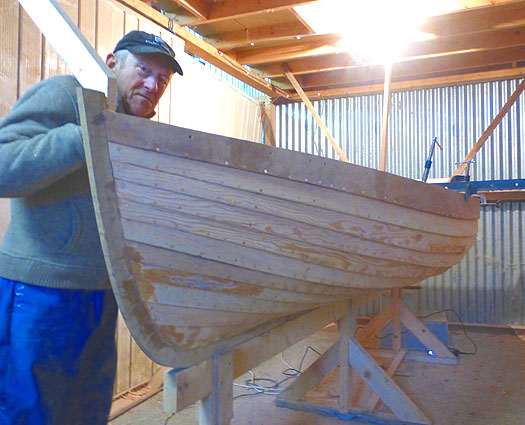
Larry Archer, best known as one of Ireland's leading glassfibre boat-building pioneers, has particularly enjoyed returning to his earlier skills as a classic wooden boatbuilder in re-creating the Asgard dinghy Photo: W M Nixon
Not least of their special joys is that, as we emerge from recession, building a small wooden boat has all the pleasures of traditional boat-building, yet with manageable expense. Thus a classic ten foot clinker dinghy perfectly fits the bill in these straitened times. And as she has the impeccable pedigree of being to a design by the great Colin Archer of Norway, the excellent value for money is beyond dispute as this little boat nears completion in a hidden shed in the depths of Fingal.
But the actual working with wood can be every bit as important as the classic or modern nature of the design, and equally intriguing is the City One project in Limerick. There, people who otherwise mightn't get a chance to build a boat, let alone sail one, are much involved with building modern dinghies to a design by Theo Rye. This is being done in a project under the Ilen umbrella, the Ilen being the Conor O'Brien ketch of 1927 which the Ilen Trust is restoring with trainee shipwrights.
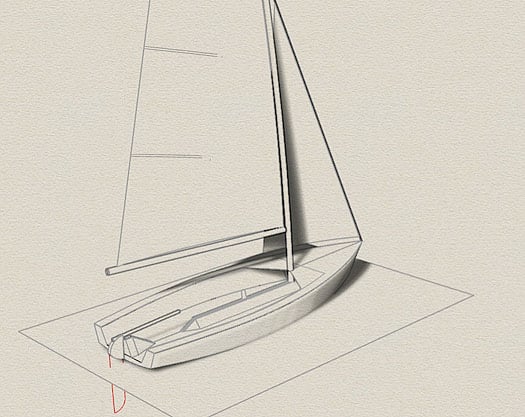
The new City One performance dinghy for Limerick has been designed by Theo Rye.
Over on the East Coast, a boat with distinctive neighbourhood sailing connections can provide a very tangible focal point where a sense of place is sometimes difficult to discern in the region's increasing urbanisation. In Bray, they're reviving that seaside town's local sailing traditions by building new boats to the 12ft Droleen design, which was designed specifically for Bray small boat enthusiasts by local sailing man W Ogilvy way back in 1897.
Ogilvy's original designs had faded, so quite some time ago the Bray people got the late O'Brien Kennedy to re-create them, and the result is such an attractive and able twelve footer that they've not only built the first new one to acclamation in Bray, but across in Spiddal on the Galway coast that renowned boat-builder Jim Horgan of Galway Boatbuilding School – who has created an astonishing total of 200 wooden boats in his time – has built another Droleen for general use in Connemara. It has proven "such a neat little boat", as he so aptly puts it, that another is likely in the near future.

"A neat little boat". The community-built Droleen nearing completion in Bray. The classic design has also been successfully used for a small workboat in Connemara
The Asgard dinghy is a replica of the little boat which Colin Archer designed and built in 1905 for Erskine and Molly Childers to be the tender for the newly-married couple's wedding present from her father, the 51ft ketch Asgard which became part of Irish history with the Howth gun-running for the Volunteers in July 1914.
Asgard is now conserved, and is the centrepiece of a simple yet very effective display in the Collins Barracks museum in Dublin. But as John Kearon and his team neared the completion of their excellent conservation project, the economic recession struck home, and it became clear that Government funds would not run to fitting any sort of rig to the boat.
However, a new squad of Volunteers emerged from a wide variety of sailing backgrounds in the hope of putting some kind of rig in place in order to give a better idea of what Asgard looked like in her prime, using spars which included the original mainboom. There was no stopping this team, which is not surprising when you consider it included global circumnavigator and former dinghy champion Pat Murphy, Arctic explorer and voyager Paddy Barry, long distance solo sailor Mike Alexander, multiple inshore and offshore sailing champion Neville Maguire, and intrepid sailor/boatbuilder Wally McGuirk and his son Rory.
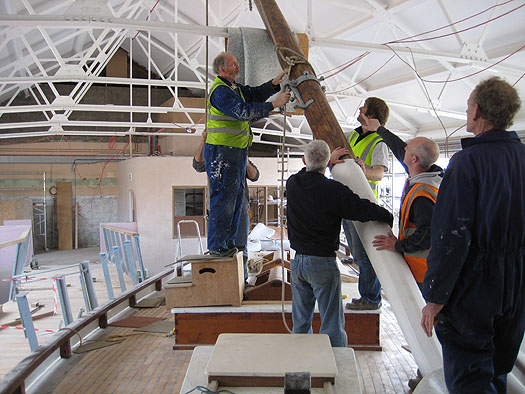
The "new Asgard volunteers" stepping the mast in Collins Barracks. Photo: Neville Maguire

Even though the rig height is very limited by a shortage of headroom, Asgard as she is now displayed looks much better for having something which shows how she appeared when fully rigged. Photo: W M Nixon
Thanks to their work, despite the limited headroom in the Asgard Museum we now have a much better idea of how this wonderful vessel looked in her prime. But as she is so permanently installed as a national monument in Collins Barracks, there's no way she's going to be readily moved for anything, not even the Centenary of the Howth Gun-Running on July 26th this year. So the new Volunteers began to think of building a replica of the Asgard dinghy, whose basic plans were discovered by John Kearon in the Colin Archer archives in the Norwegian Maritime Museum in Oslo.

Sketch plan of the proposed 10ft dinghy for Asgard as drawn by Colin Archer in 1905. Courtesy John Kearon
Though they'd made a fine job of Asgard's shortened display rig, they didn't see themselves as qualified boatbuilders for the detailed construction of a classic little clinker dinghy. But fortunately Fingal boatbuilder Larry Archer – and no, he's not Colin Archer's great-grandson as some have surmised – has the necessary traditional skills in abundance, even if he is noted as one of the pioneers of glassfibre boat-building in Ireland.
In fact, Larry is the classic illustration of my point that much as we acknowledge the sheer good sense of quality boat-building in fibreglass, there is still nothing so profoundly satisfying as traditional boat-building in wood. So he agreed to build a replica of the Asgard dinghy in a manageable budget, and as the boat nears completion, Pat Murphy has raised the money from Asgard well-wishers, and businesses in the Howth area.
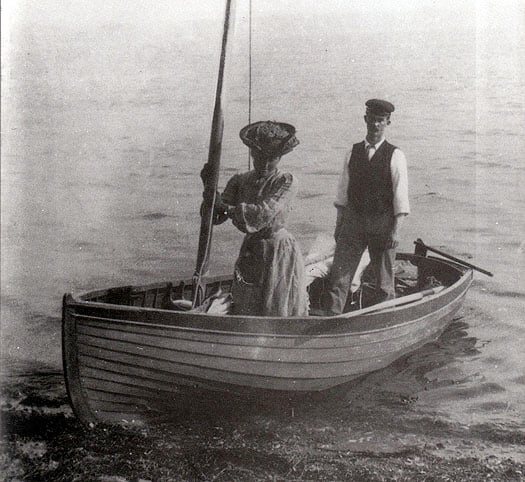
Molly and Erskine Childers with Asgard's dinghy

Asgard as seen from the dinghy during a cruise around 1910 Photo courtesy TCD.
But aside from the historical significance, like the Asgard herself this little boat has a significance all of her own. Nowadays, with the ready availability of inflatables and small RIBS to act as safe cruising yacht tenders which can be stowed on deck, we've forgotten that in times past, cruising people had to make do with dangerously small rigid boats for tenders if they wished to stow them on deck. And if they wanted a high level of safety in their tender, they had to be prepared to tow it.
In fact, in the 1930s, the Clyde Cruising Club had a rule that yachts racing in their annual Crinan to Tobermory Race, which marked the start of the traditional Glasgow Fair fortnight's holiday in July, were obliged to tow their dinghies. Much effort therefore went into designing dinghies which were safe yet sweet of line, and we've a classic photo of the great John B Kearney's 38ft yawl Mavis from Dublin Bay coming in to Tobermory in 1938 after winning the race from Crinan with the little dinghy under tow the whole way.
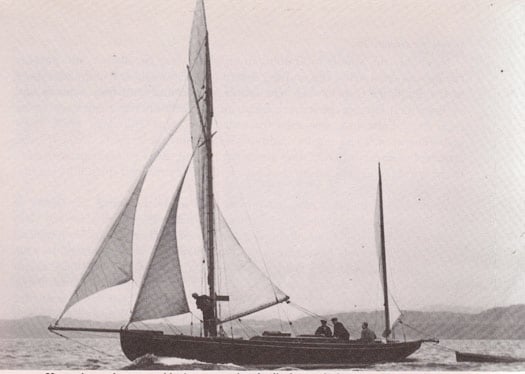
John Kearney's Mavis coming into Tobermory Bay in 1938 after winning the CCC race from Crinan, and towing the dinghy as required by club rules.
There's a direct link to the team connected with today's building of the Asgard dinghy, as the next photo we have is of Neville Maguire in his schoolboy short trousers rowing the Mavis dinghy in to the pier at Schull after placing second in the Irish Cruising Club's 1945 race from Crosshaven round the Fastnet.
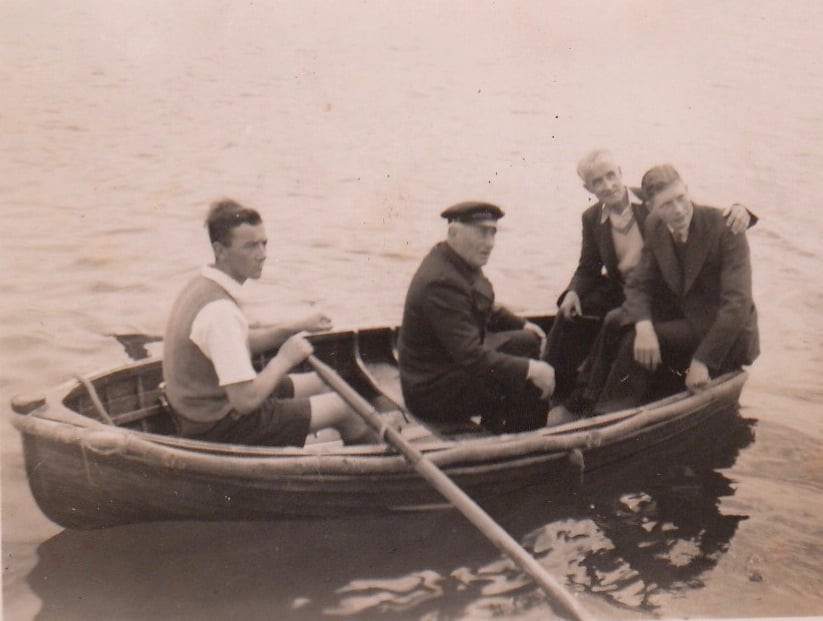
Neville Maguire in 1945, rowing the Mavis dinghy in Schull, with Skipper Kearney amidships.
To work properly, these little dinghies had to be miniature masterpieces, and in re-creating the 10ft Asgard dinghy, Larry Archer had the devil's own job in getting the planking to take on the required twist in under the transom in order to match Colin Archers tightly turned lines, which enabled the little boat to carry weight, yet tow easily and lightly when unladen. In fact, he reckons that the original must have been built with a supple newly-felled tree, whereas he was working with timber left over from the Asgard conservation, and there was one split plank before they got it right for a very fine job.
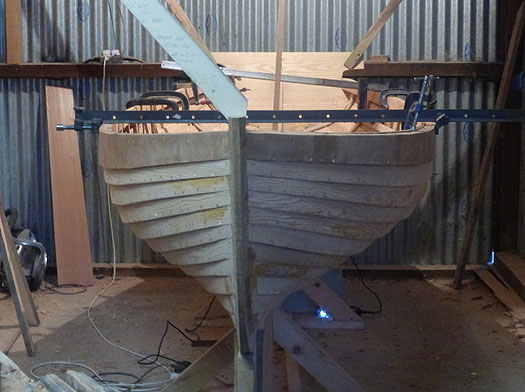
The Colin Archer-designed Asgard dinghy has a particularly elegant shape Photo: W M Nixon

As the Asgard dinghy nears completion, the tight turn to the planking under the transom is clearly seen. Photo: Pat Murphy
The boat wasn't designed with a centreplate, but she carried a little lugsail, and a rudder was fitted. Anyone who has ever sailed a clinker dinghy with the plate up will know that, from a standing start, she'll simply sail sideways. But if you get forward way built up, it's surprising how well the bit of lateral resistance provided by the rudder and the small amount of immersed hull enables you to make better to windward than just a beam reach, allowing all sorts of attractive little sailing options when the mothership is at rest in a pleasant anchorage. And if you do need to make real progress dead into the wind, she rows a treat.
Windward work will be no problem at all with the new City One dinghies from Limerick. Looking at the workmanlike lines drawn by Theo Rye, who got to know Gary MacMahon of the Ilen Trust when they were working together in the Peggy Bawn publishing team producing the massive history of the work of designer G L Watson, the analogy that springs to mind regarding windward work by the City One is "Rat up a Drainpipe".
Construction under way in Limerick on the first City One. Photo: Gary MacMahon
The emerging hull shape, designed for speed. Photo: Gary MacMahon. Photo: Gary MacMahon
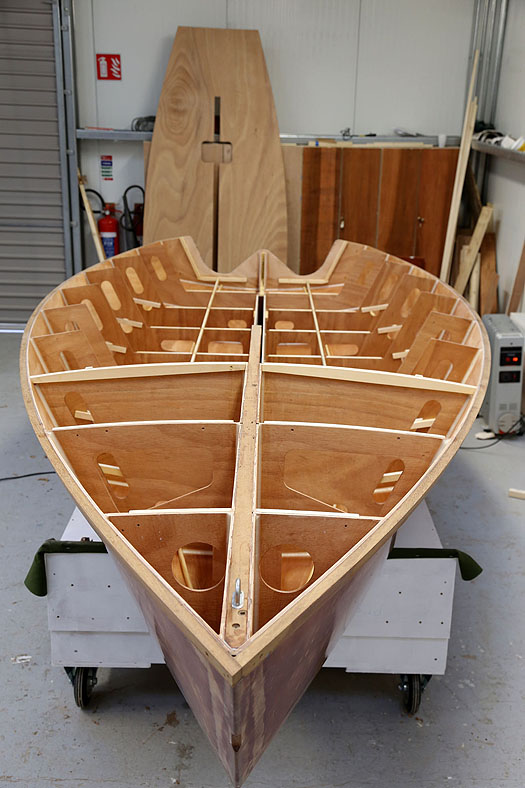
The City One is an impressive example of timber engineering. Photo Gary MacMahon
These will be potent performers, well able to hold up their heads in any race fleet, and it has been a flash of inspiration by the Ilen team to go for this type of boat rather than some sort of conservative option which would provide a maximum number of berths afloat, but a rather dull sailing experience.
By working in wood with the epoxy technique, they're getting the best of both worlds. But the Ilen organisation spreads its tentacles widely, and another of their wooden boat-building project is the re-creation of the classic Shannon and Limerick gandelows, which evolved a flat-bottomed hull shape to be able slither across those acres of mud which are inevitable at low water in the estuary, as Limerick has the biggest tidal range in all Ireland.
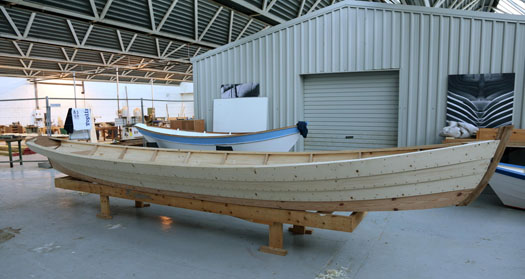
The revival of the traditional Shannon Gandelow is another Ilen Trust project. Photo: Gary MacMahon
Having been in the gondola-building boatyard on one of the Venetian islands (it's a marvellous old workshop, redolent with Stockholm tar and the aromas of fine timber), I have to concede that the Limerick gandelows are only a very distant relation of the classic Venetian originals from which they presumably derived their name. But the international brotherhood of traditional boatbuilding is strong, and the Limerick team will be taking their unusual craft to Venice on 30th April this year for racing displays.

Limerick's Liam O'Donoghue is one of those contemplating the prospect of Shannon gandelows going to Venice to link up with local gondolas. Photo: Gary MacMahon
Meanwhile in Bray so many have been involved with the truly community-wide project to re-create the Droleen class that it might be unfair to single out any one individual, but the popular Barracuda restaurant (it's above the Aquarium on the seafront south of the harbour) has been hugely supportive of a project which has already seen the first boat sailing.
She sets a fascinating rig slightly reminiscent of the setup on the first 1887 double-ended Water Wags. But where the Wags had a standing lug, the Droleens are gunter lug, with the foot of the gaff boom attached to a jaws which slides up and down the mast. Yet that startling spinnaker/jib matches the style of the original Wags, and it anticipates more modern concepts in that, in light airs at any rate, if you keep the spinnaker boom in line with main boom, you can continue to carry the "frontsail" with the wind well forward of the beam.
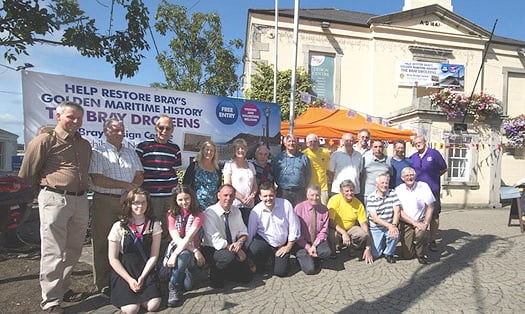
The community group involved with reviving the Droleen class. The first boat will be taking part in Bray's St Patrick's Day Parade.
In the urgency to get the boat sailing before the season had faded away completely, they got a temporary suit of sails stitched up by the fabric shop in Bray's main street, but we're assured that for the season of 2014 they'll have a grown-up suit of sails from noted local sailmaker Harry Sterling. Maybe so, but well done to the fabric shop, their temporary suit looks very well indeed, and the colour is just right to suggest cotton sails of the 1890s.

The new Droleen sailing in Bray Harbour.
The fact that this re-born design has also proven to be an ideal little workboat in on one of the rocky inlets of Connemara is yet another twist in a tale which clearly has legs. And yes, I'm well aware that there are several other wooden boatbuilders in Ireland producing interesting classic and traditional craft each in their own special way. But for now, the Asgard dinghy, the City One performance sailer, the Limerick Gandelow, and the Bray Droleen have given us more than enough to be going along with.



























